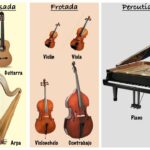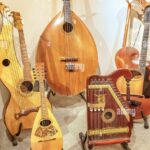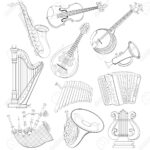
The Fascinating World of String Instruments: A Comprehensive Guide
🎻🌍
Welcome to the fascinating world of string instruments! 🎼 In this comprehensive guide, we will take a deep dive into the enchanting realm of stringed musical instruments, exploring their rich history, diverse types, and unique characteristics. Whether you’re a music enthusiast, a beginner musician, or simply curious about the magic of strings, this guide is for you!
✨ The history of string instruments traces back thousands of years, with evidence of their existence in ancient civilizations such as Mesopotamia and Egypt. From the majestic sound of the violin to the rhythmic strumming of the guitar, string instruments have played a significant role in shaping the history of music.
✨ There are several types of string instruments, each with its own distinctive sound and playing technique. Among the most well-known are the violin, viola, cello, double bass, guitar, and harp. The violin, for example, is renowned for its sweet and expressive tones, while the guitar offers versatility in various musical genres.
✨ Strings instruments are fascinating not only for their melodies but also for their intricate construction. Each instrument consists of various components, such as the body, neck, and strings, which work together to produce beautiful sounds. Violins, for instance, are carefully crafted using high-quality wood and meticulously calibrated for optimum resonance.
✨ Learning to play a string instrument can be a rewarding and fulfilling journey. The techniques required to master these instruments vary, from precise bowing and finger placements on the violin to strumming and fretting on the guitar. With dedication, practice, and guidance from experienced musicians, anyone can embark on this musical adventure.
✨ The world of string instruments is vast and diverse, with endless possibilities for exploration and creativity. Musicians have pushed the boundaries of traditional techniques, experimenting with innovative playing styles, and integrating strings into various genres such as jazz, rock, and folk. The versatility of string instruments allows for a wide range of expression and artistic interpretation.
✨ To truly appreciate the beauty and complexity of stringed instruments, it is essential to understand their history, types, and craftsmanship. This comprehensive guide aims to provide a glimpse into the captivating world of strings, inspiring you to delve deeper into the enchanting world of music. So, grab your instrument, tune your strings, and let’s embark on this musical journey together! 🎶🌟
Mastering the Craft: Learning to Play String Instruments
🎻
Why Learn to Play String Instruments?
Learning to play a string instrument is a rewarding and fulfilling experience. Whether you choose to play the violin, guitar, or cello, mastering the craft can bring immense joy and satisfaction. The ability to create beautiful melodies and express yourself through music is truly magical.
The Benefits of Playing String Instruments
Playing a string instrument offers numerous benefits. Firstly, it enhances cognitive abilities such as memory, concentration, and coordination. The complex finger movements required to produce different notes and melodies strengthen neural connections and improve overall brain function.
Choosing the Right String Instrument
When it comes to learning a string instrument, it’s important to choose the one that aligns with your musical interests and goals. Each instrument has its own unique sound and playing style, so take your time to research and try out different options. Remember, finding the instrument that resonates with you the most will greatly enhance your learning experience.
Getting Started: Lessons and Practice
To become proficient in playing a string instrument, it’s crucial to find a qualified teacher who can guide you through the learning process. Private lessons can provide personalized instruction and feedback tailored to your specific needs. Alongside lessons, consistent practice is key to mastering the craft. Dedicate regular time each day to practice scales, learn new techniques, and play songs.
Building a Strong Foundation
Mastering the craft of playing string instruments requires building a strong foundation. Start with learning proper posture and technique to avoid any potential injuries or bad habits. Practice basic scales and finger exercises to develop dexterity and finger strength. Once you have a solid foundation, you can explore more advanced techniques and repertoire.
The Joy of Playing with Others
One of the most enjoyable aspects of learning to play string instruments is the opportunity to play with others. Whether it’s in a chamber ensemble, orchestra, or band, collaborating with fellow musicians can be incredibly inspiring and educational. It allows you to refine your skills, learn from others, and create beautiful music together.
Remember, learning to play a string instrument is a journey that requires time, dedication, and patience. Embrace the challenges, stay motivated, and enjoy the process. As you progress, you’ll experience the true joy of mastering the craft and creating music that speaks to the soul. 🎶
- 💰💼 Inversiones financieras a corto plazo en instrumentos de patrimonio: ¡Descubre cómo maximizar tus ganancias!
- 🎻 Descubre la magia de los instrumentos de cuerda canarios: ¡Conoce su historia y cómo disfrutar de su encanto!
- 🔧🔎 Los mejores instrumentos a utilizar para la resolución del caso 🕵️♂️📚
- 🎵 Descubre los mejores 🎸 instrumentos de música cerca de ti 📍
- 🎵 El origen de los instrumentos musicales: ¡Descubre su fascinante historia!
Exploring the Origins and Evolution of String Instruments
🎻 Exploring the Origins and Evolution of String Instruments 🎻
String instruments have been an integral part of human culture for centuries. Their enchanting melodies have captivated audiences and brought joy to people around the world. In this article, we will delve into the fascinating journey of how string instruments came to be and the remarkable changes they have undergone throughout history.
The origins of string instruments can be traced back to ancient civilizations such as Egypt, Mesopotamia, and China. In these early cultures, string instruments were often constructed using natural materials, including animal guts and various types of wood. These primitive instruments laid the foundation for the sophisticated instruments we know today.
As time went on, string instruments evolved and became more refined. The Renaissance era saw the emergence of instruments like the lute, viol, and harp. These instruments featured strings made of gut or metal and were widely used in courtly and chamber music settings.
During the Baroque period, the violin family, including the violin, viola, cello, and double bass, took center stage. These instruments revolutionized the way music was played and composed. The addition of the bow, which allowed the strings to be played continuously, gave rise to a new level of expression and virtuosity.
In the 19th century, advancements in technology and manufacturing techniques led to the production of more standardized string instruments. The introduction of steel strings transformed the sound and projection of these instruments, making them suitable for larger concert halls and orchestras.
Fast forward to the present day, and string instruments continue to evolve. Modern luthiers push the boundaries of design and craftsmanship, creating instruments that offer unparalleled tone, playability, and aesthetics. Additionally, technological advancements have given rise to electric string instruments, expanding the possibilities for expression and experimentation.
It is truly remarkable to witness the journey of string instruments, from their humble beginnings to the phenomenal instruments they are today. Whether it’s the elegance of a classical violin concerto or the raw power of an amplified electric guitar solo, string instruments have transcended time and continue to captivate audiences around the world.
As we explore the origins and evolution of string instruments, it becomes clear that these remarkable creations have not only shaped the history of music but also continue to inspire countless musicians and music enthusiasts. So, let us embrace the beauty and richness of string instruments and celebrate their enduring legacy. 🎵
Top 5 Must-Have String Instruments for Every Musician
🎻
Welcome to our blog post discussing the top 5 must-have string instruments for every musician. Whether you’re a beginner or a professional, having a solid collection of string instruments is essential for any musician looking to expand their skills and repertoire. In this article, we will explore the five instruments that we believe every musician should have in their arsenal.
1. Violin: The violin is arguably the most iconic and versatile string instrument. Its beautiful tone and wide range make it a staple in classical music, but it can also be found in various genres like jazz, folk, and even rock. Learning to play the violin can be challenging, but the rewards are definitely worth it.
2. Guitar: The guitar is perhaps the most popular string instrument in the world. Its versatility and accessibility make it a favorite among musicians of all levels. Whether you want to strum chords or play intricate solos, the guitar is a must-have for any musician. With a wide variety of genres to choose from, you can explore any musical style that piques your interest.
3. Cello: If you’re looking for a rich and powerful sound, the cello is the instrument for you. Its deep and resonant tones are perfect for classical music and can add a soulful touch to other genres as well. The cello is a challenging instrument to master, but the emotional depth it brings to your music is unmatched.
4. Double Bass: Known for its massive size and deep tones, the double bass is the backbone of any orchestra or jazz ensemble. It provides the foundation for the music, adding depth and richness to the overall sound. While it may not be as common as other string instruments, its unique sound is definitely worth exploring.
5. Ukulele: If you’re looking for a fun and portable string instrument, the ukulele is a perfect choice. Its small size and four strings make it easy to learn and play. The ukulele is often associated with Hawaiian music, but it’s versatile enough to be used in various genres. Strumming the ukulele can instantly transport you to a tropical paradise.
In conclusion, having a collection of string instruments is crucial for any musician wanting to expand their musical horizons. Whether it’s the timeless elegance of the violin, the versatility of the guitar, the emotional depth of the cello, the powerful presence of the double bass, or the playful charm of the ukulele, each instrument offers something unique. So go ahead and explore these must-have string instruments, and let your creativity soar! ✨
Choosing the Perfect String Instrument: A Buyer’s Guide
🎻
When it comes to choosing the perfect string instrument, there are several factors to consider. Whether you are a beginner or a seasoned player, finding the right instrument can make all the difference in your musical journey. In this buyer’s guide, we will explore the key aspects to keep in mind when making this important decision.
Firstly, it’s important to define the type of string instrument you are interested in. From violins to cellos, violas to double basses, each instrument offers its own unique sound and qualities. Consider the genre of music you wish to play and the sound you are aiming for. Research the different types and listen to recordings to get a better understanding of their tonal characteristics.
Next, determine your skill level and budget. If you are a beginner, you may want to start with a more affordable instrument that still offers good quality. As you progress, you can upgrade to a higher-end instrument. It’s important to strike a balance between your budget and the quality of the instrument to ensure you are getting the best value for your money.
Finally, consider trying out the instrument before making a decision. Visit a music store or attend an orchestra concert to personally experience the sound and feel of the instruments. This hands-on approach will give you a better sense of which instrument resonates with you the most. Remember, finding the perfect string instrument is a personal journey, and it’s important to choose one that inspires and captivates you.
 🎻 Descubre los 🎵 nombres de los instrumentos musicales de cuerda más populares
🎻 Descubre los 🎵 nombres de los instrumentos musicales de cuerda más populares 🎻📷 Descubre los hermosos instrumentos de cuerda: ¡imágenes que te cautivarán!
🎻📷 Descubre los hermosos instrumentos de cuerda: ¡imágenes que te cautivarán! 🎻✍️ Descubre cómo dibujar instrumentos de cuerda como un profesional
🎻✍️ Descubre cómo dibujar instrumentos de cuerda como un profesional 🎻 Descubre qué instrumentos tocaba Vivaldi: Guía completa y fascinante
🎻 Descubre qué instrumentos tocaba Vivaldi: Guía completa y fascinante 🎵 ¡Descubre qué instrumentos tocaba Johann Sebastian Bach! | Guía completa 🎶
🎵 ¡Descubre qué instrumentos tocaba Johann Sebastian Bach! | Guía completa 🎶 🎻🖍️ Descubre los mejores instrumentos de cuerda para colorear: ¡diversión y aprendizaje en uno solo!
🎻🖍️ Descubre los mejores instrumentos de cuerda para colorear: ¡diversión y aprendizaje en uno solo! 🎻 Descubre los mejores instrumentos de cuerda: ¡La lista definitiva!
🎻 Descubre los mejores instrumentos de cuerda: ¡La lista definitiva! 🎻📚 Todo lo que necesitas saber sobre instrumentos de cuerda: información y consejos esenciales
🎻📚 Todo lo que necesitas saber sobre instrumentos de cuerda: información y consejos esenciales 🎻🎼 Descubre los mejores instrumentos de cuerda para una orquesta sinfónica
🎻🎼 Descubre los mejores instrumentos de cuerda para una orquesta sinfónica